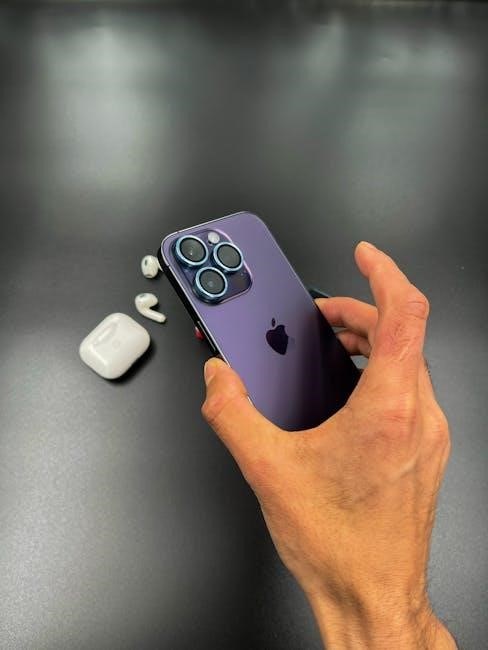
The Infant/Toddler Environment Rating Scale, Third Edition (ITERS-3), is a comprehensive assessment tool designed to evaluate the quality of care for infants and toddlers in center-based programs. It focuses on observing environments, activities, and interactions to promote optimal development and improve early childhood education quality. This updated version provides a detailed framework for understanding and enhancing care settings, ensuring alignment with current research and best practices in early childhood education.
1.1 Overview of the Infant/Toddler Environment Rating Scale
ITERS-3 is a widely used assessment tool designed to evaluate the quality of care for infants and toddlers in center-based programs. It focuses on observing the environment, activities, and interactions to ensure they meet the developmental needs of children from birth to 36 months. The scale consists of 39 items organized into seven environmental subscales, providing a comprehensive framework for understanding and improving care settings. It emphasizes the importance of a nurturing environment, appropriate materials, and responsive interactions to support early childhood development and learning.
1.2 Importance of ITERS-3 in Early Childhood Education
ITERS-3 plays a crucial role in early childhood education by providing a standardized framework to assess and improve the quality of care for infants and toddlers. It helps educators identify strengths and areas for growth, ensuring environments are safe, stimulating, and responsive to young children’s needs. By focusing on key aspects like space, materials, and interactions, ITERS-3 supports the development of essential skills, fostering a foundation for future academic and social success. Its implementation promotes consistency and excellence in early childhood programs.

Key Components of ITERS-3
ITERS-3 evaluates infant and toddler care programs through subscales and indicators, focusing on environment, activities, and caregiving practices to enhance overall program quality and developmental support.
2.1 Subscales and Indicators
ITERS-3 is structured into seven environmental subscales, each containing specific indicators to assess program quality. These subscales include Space and Furnishings, Materials and Activities, and Health and Safety. Indicators within these subscales evaluate aspects such as the availability of books, variety of toys, and safety protocols. Each indicator is scored on a scale, with responses ranging from “Yes” or “No” to a numerical rating. This detailed framework ensures a thorough evaluation of the care environment, guiding improvements to support infant and toddler development effectively.
2.2 Focus on Infants’ and Toddlers’ Needs
ITERS-3 emphasizes the unique needs of infants and toddlers, ensuring their environments support physical, emotional, and cognitive development. The scale prioritizes safety, age-appropriate materials, and opportunities for exploration and interaction. It evaluates how well programs foster curiosity, language development, and motor skills through accessible toys, books, and nurturing interactions. This focus helps create a stimulating yet secure setting, tailored to the developmental stages of young children, promoting their overall well-being and readiness for future learning experiences.

Environmental Subscales
The ITERS-3 Environmental Subscales assess the quality of spaces, materials, and health practices to ensure safe and stimulating environments for infants and toddlers.
3.1 Space and Furnishings
ITERS-3 emphasizes the importance of safe, accessible, and well-organized spaces for infants and toddlers. Furnishings should promote comfort, exploration, and motor skill development. The environment must ensure clarity of purpose for different activity areas, such as sleeping, eating, and play. Storage solutions should be child-friendly, fostering independence. Lighting should be soft and appropriate to create a calming atmosphere. Spaces should also reflect the cultural and individual needs of children, ensuring inclusivity and a sense of belonging.
3.2 Materials and Activities
ITERS-3 evaluates the availability and quality of materials and activities that promote learning and engagement. More than 5 accessible books, including fiction and factual options, are essential. Art supplies, musical instruments, and fine motor toys should be present to encourage creativity and skill development. Activities must be age-appropriate, diverse, and inclusive, fostering exploration and curiosity. Materials should be well-organized and within children’s reach, supporting independent play and cognitive growth while ensuring safety and cultural relevance.
3.3 Health and Safety
ITERS-3 emphasizes adherence to health and safety protocols to protect infants and toddlers. This includes proper handwashing, diapering procedures, and meal guidelines. Cleanliness of toys, surfaces, and equipment is prioritized, with clear schedules for sanitization. Safe sleep practices and hazard-free environments are essential. Staff must be trained in safety procedures, and first aid kits should be accessible. These standards ensure a hygienic and secure setting, promoting children’s well-being and preventing potential risks.

Assessment Process
The ITERS-3 assessment involves observations and staff interviews, using a 39-item rating scale to evaluate program quality; It helps identify strengths and areas needing improvement.
4.1 Observation and Staff Interviews
The ITERS-3 assessment process involves detailed observations of the environment and activities, as well as interviews with staff to gather insights into daily practices. Observations focus on interactions, materials, and the physical setup to evaluate how well they support children’s development. Interviews provide additional context about routines, caregiver strategies, and program goals. This dual approach ensures a comprehensive understanding of the program’s quality and identifies areas for improvement. Both methods are essential for an accurate and thorough evaluation of infant and toddler care settings.
4.2 Scoring System and Interpretation
The ITERS-3 utilizes a scoring system where each item is rated on a scale, with indicators scored as “Yes” or “No” or rated numerically. Scores are summed to provide an overall quality assessment. Interpretation involves analyzing these scores to identify strengths and areas needing improvement. This system helps programs understand their performance and guide targeted enhancements, ensuring a focus on continuous quality improvement for infant and toddler care environments. The scoring process is detailed in the ITERS-3 manual, providing clear guidelines for accurate evaluation and interpretation.

Resources for ITERS-3 Implementation
Key resources include score sheets, checklists, and supplementary guidelines. The ITERS-3 manual offers detailed instructions, while additional materials like handwashing and diapering procedures support effective implementation and quality improvement.

5.1 Score Sheets and Checklists
Official ITERS-3 score sheets and checklists are essential tools for evaluating program quality. The Expanded Score Sheet provides detailed item-by-item assessments, while materials checklists ensure proper resources are available; These resources guide observers in evaluating spaces, activities, and interactions. Supplementary materials, such as handwashing and diapering guidelines, further support implementation. By using these tools, programs can identify strengths and areas for improvement, ensuring high-quality care for infants and toddlers. They are indispensable for accurate assessments and continuous quality enhancement.
5.2 Supplementary Materials and Guidelines
Supplementary materials for ITERS-3 include detailed manuals, such as the “ITERS-R” and “All About the ITERS-R,” which provide in-depth guidance for effective implementation. These resources offer practical strategies for improving program quality. Additional tools, like lesson plan templates and activity guides, support educators in creating engaging environments. Supplementary notes and updated guidelines address specific areas, such as book selection and sensory play, ensuring comprehensive support for early childhood programs. These materials are designed to enhance understanding and application of the ITERS-3 framework.

Practical Applications of ITERS-3
ITERS-3 provides practical strategies for improving care quality, focusing on encouraging children’s use of books and supporting language development through interactive activities and meaningful interactions.
6.1 Encouraging Children’s Use of Books
ITERS-3 emphasizes creating a stimulating environment with accessible books for infants and toddlers. Programs should ensure more than five books are available, including fiction and factual ones, arranged in low shelving or baskets. Cozy reading areas with cushions and displays of children’s artwork encourage exploration. Adults should engage children in storytelling, discussions, and book-related activities to foster language development and a love for reading. Regular rotation of books and connecting stories to children’s interests further enhance engagement and learning opportunities.
6.2 Supporting Language and Cognitive Development
ITERS-3 highlights strategies to enhance language and cognitive growth in infants and toddlers. This includes providing opportunities for talking, listening, and responding to verbal cues. Encouraging descriptive language by naming objects and actions supports vocabulary development. Offering problem-solving activities, such as puzzles and sensory play, fosters critical thinking. Engaging children in conversations, reading aloud, and using open-ended questions stimulates their curiosity and exploration. Creating a language-rich environment with music, rhymes, and storytelling further enhances their cognitive and linguistic abilities, laying a strong foundation for future learning and communication skills. Mirrors and reflective surfaces also encourage self-discovery and cognitive engagement, aligning with ITERS-3 guidelines for stimulating environments that promote active learning and development.

Best Practices for Quality Improvement
Implementing staff training, creating stimulating environments, and utilizing ITERS-3 frameworks are essential for continuous quality improvement in early childhood education settings.
7.1 Creating a Stimulating Environment
Creating a stimulating environment involves organizing space, materials, and activities to promote infants’ and toddlers’ exploration and learning. Access to books, art, and age-appropriate materials fosters cognitive growth. Displaying children’s artwork and using colorful mobiles enhances visual stimulation. Ensuring materials are within reach encourages independence. Safe, well-organized spaces allow for free movement and discovery, aligning with ITERS-3 guidelines to support overall development and engagement.
7.2 Staff Training and Professional Development
Staff training and professional development are critical for improving program quality. Ongoing education ensures caregivers understand child development principles and best practices. Training focuses on creating stimulating environments, fostering language skills, and ensuring safety. Resources like ITERS-3 score sheets and guidelines help staff self-assess and improve. Professional development encourages reflective practice, enhancing staff’s ability to meet infants’ and toddlers’ needs effectively. Continuous learning fosters a supportive and engaging environment, aligning with ITERS-3 standards for high-quality care.

Future Trends in Early Childhood Care
Future trends emphasize integrating technology, sustainability, and inclusivity into care settings. Innovative materials and adaptive environments will support diverse needs, fostering holistic development in early childhood education.
8.1 Integrating Technology and Innovation
Integrating technology and innovation into early childhood care is becoming a key trend. Digital tools, such as interactive learning apps and educational software, are being used to enhance cognitive and motor skills. Sensors and smart devices can monitor environmental factors like lighting and noise, ensuring a safe and stimulating space. Additionally, virtual reality and augmented reality are being explored to create immersive learning experiences tailored to infants’ and toddlers’ developmental needs. These advancements aim to bridge traditional care practices with modern technological solutions, fostering a more engaging and adaptive environment for young learners.
8.2 Focus on Sustainability and Inclusivity
Modern early childhood care increasingly emphasizes sustainability and inclusivity. ITERS-3 highlights the importance of eco-friendly practices, such as using recycled materials and promoting energy efficiency. Inclusivity is prioritized through diverse representations in toys, books, and activities, ensuring all children feel valued. Programs are encouraged to adopt culturally sensitive approaches and provide accessible resources for children with varying abilities. This focus ensures environments are not only nurturing but also equitable and environmentally conscious, aligning with global trends in education and care.
The ITERS-3 plays a crucial role in modern early childhood education by providing a comprehensive framework to enhance care quality and align with best practices for future development.
9.1 The Role of ITERS-3 in Modern Education
ITERS-3 serves as a vital tool in modern early childhood education, providing a comprehensive framework to assess and enhance the quality of care for infants and toddlers. By focusing on environmental factors, activities, and staff-child interactions, it ensures holistic development. The scale emphasizes the importance of space, materials, health, and safety, aligning with contemporary research on child development. Its practical checklists and guidelines empower educators to create nurturing environments, fostering cognitive, social, and emotional growth. This makes ITERS-3 indispensable for improving early childhood programs worldwide.
9.2 Final Thoughts on Quality Improvement
ITERS-3 underscores the importance of continuous quality improvement in early childhood education. By providing clear guidelines and assessment tools, it empowers educators to create environments that nurture infant and toddler development. The scale’s focus on observation, staff training, and environmental optimization ensures that programs can identify and address areas for growth. Ultimately, ITERS-3 serves as a catalyst for enhancing care quality, fostering a culture of excellence, and supporting the critical early years of a child’s life.